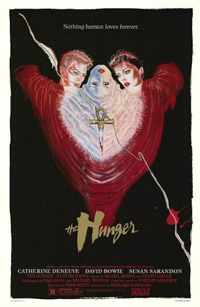 Roundly dismissed upon its release by critics in 1983, Tony Scott’s classy, stylish art-house vampire film The Hunger arrives on Blu-ray as a demure addition to the Warner Bros. Archive Collection. A notable cult item still lacking of a deserving reappraisal for its significant merits, the film has long languished in obscurity with the exception of its references to the explicit lesbian sex scene shared between Catherine Deneuve and Susan Sarandon (featured in a first-wave resurgence of interest in LGBT cinematic themes with the documentary version of Vito Russo’s The Celluloid Closet, 1991). It represents one of three cinematic adaptations from horror writer Whitley Streiber, following the also forgotten Wolfen (1981), starring Albert Finney.
Roundly dismissed upon its release by critics in 1983, Tony Scott’s classy, stylish art-house vampire film The Hunger arrives on Blu-ray as a demure addition to the Warner Bros. Archive Collection. A notable cult item still lacking of a deserving reappraisal for its significant merits, the film has long languished in obscurity with the exception of its references to the explicit lesbian sex scene shared between Catherine Deneuve and Susan Sarandon (featured in a first-wave resurgence of interest in LGBT cinematic themes with the documentary version of Vito Russo’s The Celluloid Closet, 1991). It represents one of three cinematic adaptations from horror writer Whitley Streiber, following the also forgotten Wolfen (1981), starring Albert Finney.
Miriam Blaylock (Deneuve) is an ancient yet breathtakingly beautiful vampire. Her lover of the past three centuries, John (David Bowie) has suddenly begun to age and decay, apparently something that has eventually happened to all of her past lovers, necessitating she continually find another. Unfortunately, her lovers can’t die, but just wither away into feeble bodies she basically locks up in the attic. John’s attempted contact with a geriatrics researcher (Sarandon) who is specifically researching the relationship between sleep and age brings the doctor into Miriam’s clutches.
Due to its failings, director Tony Scott, brother of Ridley, would abandon any further experiments in artistic cinema, turning to the mainstream sensibilities of Top Gun (1985) and Beverly Hills Cop II (1987) and solidifying himself as an action film auteur. And yet, to revisit his exquisitely sleek directorial debut, Scott’s expert visual formulations recall the similarly defined sensibilities of his brother’s earlier hailed genre masterpieces, like Alien (1979) and Blade Runner (1982).
A revisionist vampire film (hence, you never hear anyone utter the word), The Hunger announces its intentions in the opening credits, where Deneuve and Bowie pick out victims at a club (including Ann Magnusson) edited into the gothic overtones of a diegetic Bauhaus track, “Bela Lugosi’s Dead.” These are not the bloodsucking, shamed creatures plaguing innocent humans over the past century, announced aggressively by its opening track. Indeed, the crumbling façade of the nocturnal predators is nowhere to be seen in this unabashedly decadent exploration of selfishness and even classism. As the vampiric lovers decimate their victims, Scott juxtaposes violent imagery of primates attacking one another from Sarandon’s gerontology lab, suggesting an evolution in motif and form—themes explored again nearly two decades later in Claire Denis’ Trouble Every Day (2001).
Much like the non-human replicants of Blade Runner, Scott’s vampires are entrenched in their own battles with aging, immortality, and the decay of beauty. Though Scott pares down Streiber’s original text to the barest essentials, allowing many to criticize the film’s championing of style over substance, this is ultimately untrue.
An exploration of decadence, at the height of the notorious age of excess, The Hunger is fascinated with the superficiality of flesh and the hollow notion of love once youth’s bloom has faded. Deneuve’s icy, elegant Miriam is a penultimate example of selfish love, for once she loses interest in her chosen, immortal lover, they inextricably age but are unable to die, forcing her to lock them into a wooden box, stacking them on top of one another in a dove-filled belfry. Though still remembered for its provocative sex scene between Deneuve and Sarandon, which still manages to be bold, tasteful, and refreshingly forthright, the legacy of this scene has perhaps eclipsed the breathtaking mood of the rest of the film. Bowie seems to fall to the wayside, but is the palette for which make-up artist Dick Smith projects a wonderful reenactment of advanced ageing.
Its human characters are presented as overly emotional, even hysterically prone beings, such as Sarandon’s doctor and her casual relationship with a fellow colleague played by Cliff De Young (note early roles for Dan Hedaya and Willem Dafoe). Deneuve, on the other hand, is the film’s controlled center of languid affection, telepathically directing those she marked as her prey. An ambient finale features a key character fall through the spaces between a flight of stairs, crashing down through the unmarked territory of the physically defined stairway, the human symbol as impetus of ascension.
Disc Review:
Yes, Roger Ebert may have disliked all the billowing curtains, but Stephen Goldblatt’s ethereal cinematography is hypnotic. The high-definition transfer, presented in 2.40:1 is a necessary updated edition of a neglected genre masterpiece. However, that said, Warner Bros. simply includes the lone special feature included on the previous DVD release, commentary from Sarandon and Tony Scott (still well worth a listen). With Scott’s death in 2012 and a significantly changed political landscape since the film was last vocally discussed in the early 1990s, The Hunger is still due certain reconsideration.
Final Thoughts:
Moody, elegant, and undeniably cool, The Hunger stands alongside the likes of Daughters of Darkness (1971) as one of the best artistic cinematic representations of the vampire ever made.
Film Review: ★★★★/☆☆☆☆☆
Disc Review: ★★★½/☆☆☆☆☆


